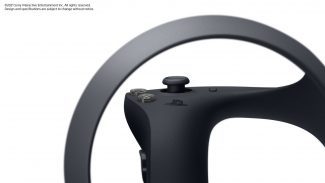A report from UploadVR, citing “multiple sources,” claims that Sony’s next-gen PlayStation VR 2 headset will bring a big jump in resolution, along with eye-tracking, IPD adjustment, and even head-mounted haptics.
UploadVR today reported that “multiple sources” shared details about the PSVR 2 headset after Sony revealed info to partners. Here’s the key info claimed in the report:
- 4.1MP (2,000 × 2,040) per-eye resolution
- IPD adjustment dial
- Eye-tracking capable of foveated rendering
- USB-C tether to PS5
- Inside-out tracking
- Head-mounted haptics
Road to VR has not been able to independently verify details of the report, though several sources says that these sorts of leaks tend to be the result of details shared with third-party developers.
Resolution
At 4.1 megapixels (2,000 × 2,040) per-eye, PSVR 2 would have one of the highest resolution displays among consumer VR headsets today, beat out only by the HP Reverb G2. This would dwarf the 1.0 megapixel per-eye of the original PSVR.
| Headset | Megapixels per-eye | Released |
| PSVR | 1.0 | 2016 |
| Rift CV1 | 1.3 | 2016 |
| Rift S | 1.8 | 2019 |
| Vive Pro | 2.3 | 2018 |
| Quest | 2.3 | 2019 |
| Index | 2.3 | 2019 |
| Quest 2 | 3.5 | 2020 |
| PSVR 2 (rumored) | 4.1 | After 2021 |
| Reverb G2 | 4.7 | 2020 |
IPD Adjustment
The report also claims the headset will have an IPD adjustment dial which will allow users to change the distance between the lenses to match the distance between their eyes. Doing so increases comfort and clarity by making sure the ‘sweet spot’ of the lens is closely aligned with the center of the eye.
The original PSVR didn’t have a physical IPD adjustment, and generally didn’t seem to need one thanks to optics which gave the headset a fairly large sweet spot. The addition of an IPD adjustment on PSVR 2 could signal a major change in lens design; the original PSVR was one of the only headsets in the category to not use fresnel lenses.
Eye-tracking
The report from UploadVR also says the headset will be equipped with eye-tracking, which can bring a host of benefits to a VR headset, but to date we haven’t seen any consumer VR headset equipped with eye-tracking. Beyond foveated rendering (which can allow the headset to render a sharper view only where the user is looking), eye-tracking could pair well with the purported IPD adjustment, as the eye-tracking could be used to measure the ideal IPD value of the user.
Inside-out Tracking
The PSVR 2 is also said to use inside-out tracking, which means the headset will use on-board cameras to track its location and the location of the controllers. This is the same approach used by headsets like Oculus Quest.

This would also be a big shift, as the original PSVR relied on the PS4 camera for tracking, which ultimately limited the headset’s tracking quality and range. This limited tracking made the headset more restrictive for developers, and less convenient for users. Inside-out tracking, on the other hand, stands to bring 360° tracking and the potential for ‘room-scale’ playspaces to the headset.
USB-C Tether
The UploadVR report says the headset will connect to PS5 via a USB-C tether, which could conveniently plug into the existing USB-C port on the front of the console. It would be a big win if the headset can use a single cable straight into the console for power, video, and data, because the original headset’s breakout box and many cables are quite cumbersome.
Head-mounted Haptics
Perhaps the most unexpected part of the report is the mention of head-mounted haptics. PSVR 2 would be the first consumer headset to include this sort of feature, which would ostensibly allow the headset to vibrate or rumble in order to provide extra feedback to the user. Combined with the DualSense adaptive triggers in the headset’s new controllers, this could make the next PSVR one of the most hapticly-capable VR systems to date.
Beyond just offering more immersion, head-mounted haptics have even been shown as a potential avenue for improving comfort while in VR. Apple has also been looking into the idea of head-mounted haptics to aid navigation in virtual spaces.
– – — – –
If true, this is a good deal of info to know about the headset already, even before it has been officially revealed. Sony has said previously the headset won’t launch until sometime after 2021, so it seems it will be a while yet before we get other essential details like a price and release date for PSVR 2.
Article From & Read More ( Report: Next-gen PSVR Said to Have 4.1MP Per-eye, Eye-tracking, & Head-mounted Haptics - Road to VR )https://ift.tt/3hh33mT
Technology
Bagikan Berita Ini















0 Response to "Report: Next-gen PSVR Said to Have 4.1MP Per-eye, Eye-tracking, & Head-mounted Haptics - Road to VR"
Post a Comment